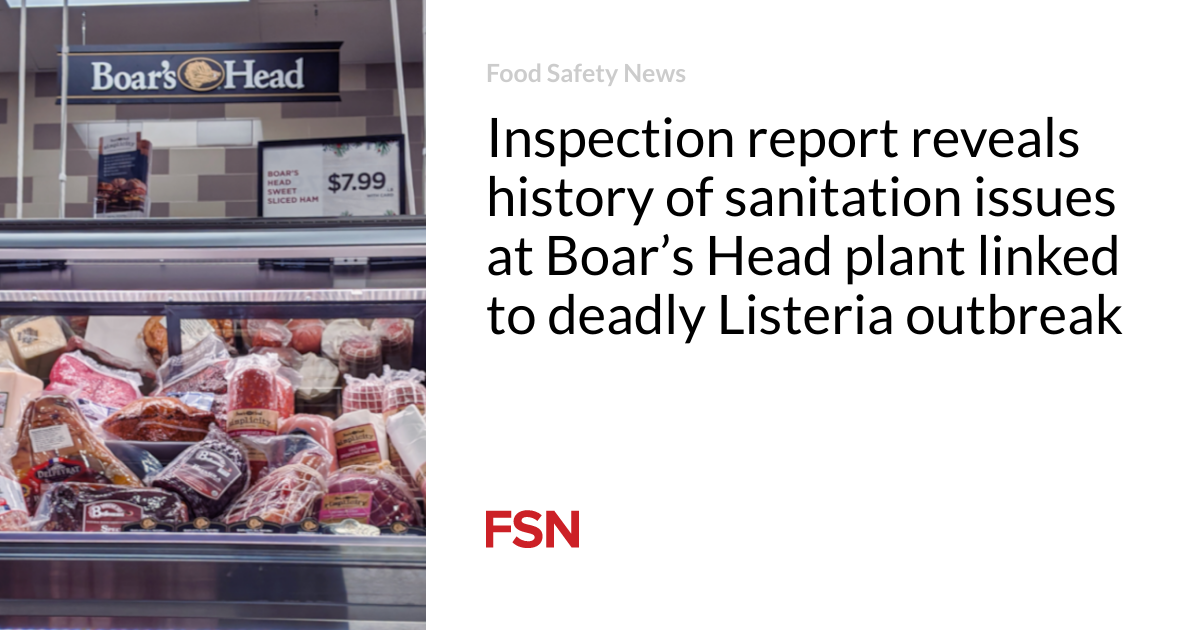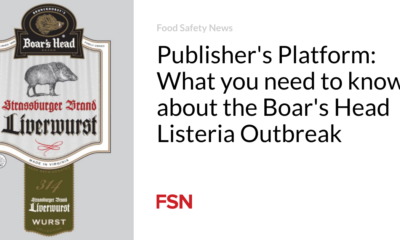Food
Inspection report reveals history of sanitary problems at Boar’s Head factory linked to deadly Listeria outbreak

More than a year of repeated sanitation deficiencies – 69 violations in all – at the Boar’s Head plant in Virginia appears to have fueled the ongoing Listeria outbreak, which has sickened 57 people in 18 states and claimed nine lives.
A U.S. Department of Agriculture inspection report reporting significant sanitation deficiencies at a Boar’s Head meat processing plant in Jarratt, VA, has revealed significant sanitation problems. This revelation comes as the Centers for Disease Control and Prevention continues to monitor the Listeria outbreak linked to the company’s processed meats. The inspection report, obtained by CBS News through a Freedom of Information Act (FOIA) request, documents 69 noncompliance events observed by USDA Food Safety and Inspection Service (FSIS) inspectors between August 1, 2023 and August 2, 2024 .
Ongoing Listeria outbreak
The CDC reported 14 this week Aadditional illnesses and five more deaths from the Listeria outbreak since the previous update on August 8. All 57 confirmed patients have required hospitalization, and public health officials warn that the actual number of cases could be higher because many individuals are able to recover without seeking medical care or being tested for Listeria.
The outbreak has been traced to processed meats, especially those sliced in delis, with Boar’s Head liverwurst being a major contributor. Epidemiological and laboratory data have identified Listeria in Boar’s Head deli meats sampled at stores in Maryland and New York, with whole genome sequencing confirming that the bacterial strain found in these products matches the one causing the outbreak.
Sanitary facilities at Boar’s Head facility
The FSIS inspection report highlights a troubling series of sanitation violations at the Jarratt plant, raising concerns about the facility’s ability to prevent contamination. The violations documented in the report include the presence of mold and mildew on surfaces that employees use to wash their hands, on the outside of steel drums and in coolers between smokehouses. These conditions are particularly concerning given Listeria monocytogenes’ ability to thrive in cold, moist environments.
In a statement to CBS News, Boar’s Head spokesperson Elizabeth Ward expressed the company’s regret over the impact of the recall and emphasized that food safety is their “absolute priority.” Ward also tried to blame the government: “As a USDA-inspected food manufacturer, the agency has inspectors at our Jarratt, VA facility every day, and if at any time inspectors identify something that needs to be addressed, our team does so as well. immediately, as was the case with every issue raised by USDA in this report.”
Some of the most important findings from the inspection report
Below is a list of some of the violations found at the Boar’s Head factory in Jarratt:
- August 3, 2023: Inspectors found heavy discolored meat build-ups on a hydraulic pump and meat particles in hypodermic needles. The area had a strong odor and inspectors observed meat, pieces of wood and plastic waste on the floor.
- August 25, 2023: Condensation was found along the doorframe of a cooler in the Ready-to-Eat (RTE) packaging department. This can lead to contamination of products stored in the cooler.
- September 22, 2023: Inspectors found meat residue on food contact surfaces within the Stitch Pump department, including in fuel hoppers and on hypodermic needles. Also, a drain in a saddle tank was clogged with meat, creating an unsanitary condition.
- November 7, 2023: An inspection found that five Hazard Analysis Critical Control Point (HACCP) documents had discrepancies in thermometer calibration, posing a food safety risk.
- January 9, 2024: A black mold-like substance was found in the cooler between the smokehouses and the stanchion pump. The affected areas ranged in size from small spots to several meters in diameter.
- February 21, 2024: Multiple combos in the Raw Receiving cooler were found saturated with blood and heavily contaminated, with a rancid odor permeating the area.
- March 13, 2024: Inspectors noted a significant buildup of meat proteins and waste in inedible chamber No. 2, along with improperly handled inedible products, including whole pork muscles left in stainless steel vats.
- March 20, 2024: A Boar’s Head Brand Bologna product tree in the RTE Department’s Equalization Cooler #2 was missing proper ID tags or labels, raising concerns about product traceability.
- May 20, 2024: At the Frank Stuffing department, white meat remains were found covering several parts of the floor, a drain overflowing and pieces of meat embedded in production lines.
- June 7, 2024: Three tree racks of metal products at the New Gourmet staging area were found with meat residue from previous production on their food contact surfaces.
The full inspection report can be found here.
Impact of sanitation failure on Listeria contamination
The inspection report’s findings are especially alarming given Listeria’s ability to survive and even thrive in cold, damp environments such as those found in food processing facilities. The repeated failure to adequately clean and maintain equipment and surfaces at the Jarratt plant creates conditions ripe for Listeria contamination. The ongoing outbreak, which has already caused serious illness and deaths, underlines the public health risks associated with these sanitation deficiencies.
The FSIS report notes that many of the observed non-compliances were resolved by re-cleaning and disinfecting the affected areas. However, the recurrence of these problems indicates systemic problems within the facility’s sanitation system. The presence of mold and meat residue in critical areas of the plant highlights the challenges the plant faces in maintaining a safe processing environment.
Public health concerns
The USDA and FSIS have been actively involved in responding to the Listeria outbreak and are working with the CDC and state health departments to track the source of the contamination and monitor product recalls. Boar’s Head has already recalled more than 7 million pounds of processed meats due to the outbreak. However, the inspection report raises questions about the effectiveness of the company’s corrective actions and its ability to prevent future contamination.
Public health officials continue to emphasize the importance of strict adherence to sanitary protocols in meat processing facilities. The findings of the Jarratt factory inspection are a stark reminder of the crucial role that sanitation plays in ensuring food safety. The conditions observed in the factory not only violate legal standards, but also pose a direct threat to public health.
About Listeria infections
Food contaminated with Listeria monocytogenes may not look or smell putrid, but it can still cause serious and sometimes life-threatening infections. Anyone who has eaten recalled products and developed symptoms of a Listeria infection should seek medical attention and tell their doctor about possible Listeria exposure.
Also, anyone who has eaten any of the recalled products should monitor themselves for symptoms in the coming weeks, as symptoms of listeriosis can develop up to 70 days after exposure to Listeria.
Symptoms of a Listeria infection may include vomiting, nausea, persistent fever, muscle aches, severe headaches, and neck stiffness. Specific laboratory tests are needed to diagnose Listeria infections, which can mimic other diseases.
Pregnant women, the elderly, young children and people such as cancer patients with weakened immune systems are at particular risk of serious illness, life-threatening infections, other complications and death. Although infected pregnant women may experience only mild, flu-like symptoms, their infections can lead to preterm labor, infection of the newborn, or even stillbirth.
(To sign up for a free subscription to Food Safety News, click here.)













